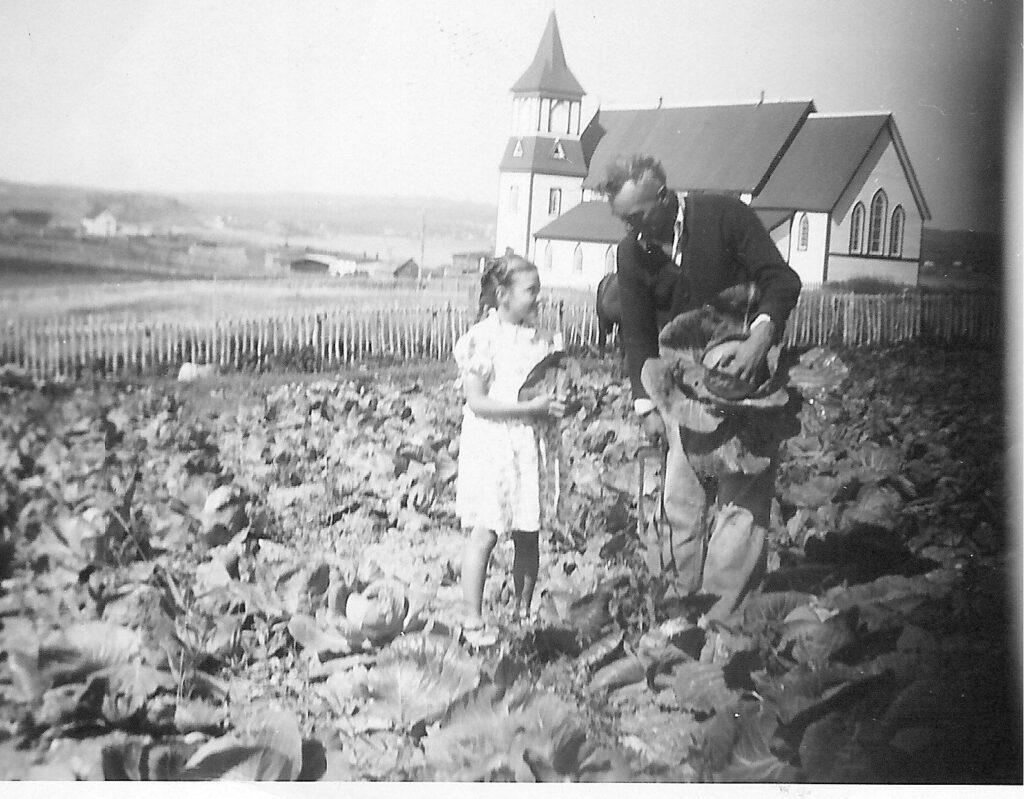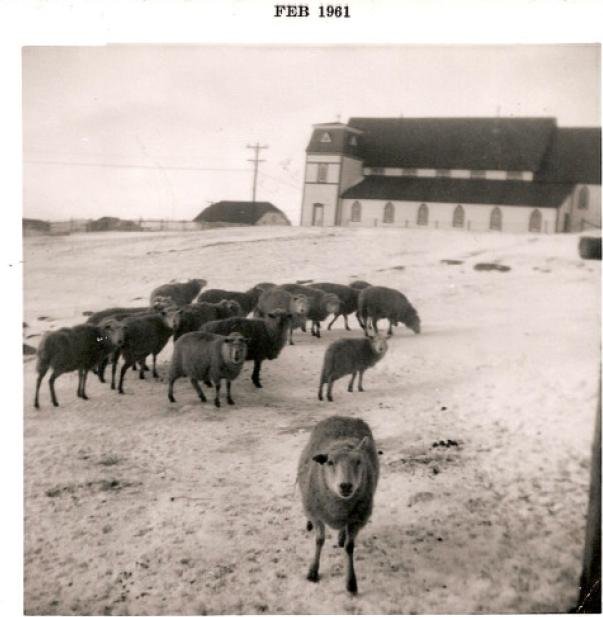Agriculture
While Agriculture might not be the first item that one might associate with a Newfoundland fishing community it did play a significant role in allowing the people of Bareneed to survive and prosper. The Plantation Book compiled in 1805 (see earlier discussion) shows that many of the fishermen living in Bareneed had gardens and pastures. These were used to grow potatoes, turnips and cabbages (these reduced the dependence on imported flour since wheat would not grow in Newfoundland) and for raising animals for meat, milk and butter. In addition, if there was a failure in the fishery (due to catch or price) these might be the only way to survive.
The importance of developing agriculture in Newfoundland to prevent starvation in bad years was recognized as early as 1817. After the winter of 1817, when there were severe food shortages in Newfoundland (see history section), there were several letters sent to the governor pointing out the importance of developing local agriculture.
The following description of a bad fishing year (Labrador fishery) written in 1894 by a minister at Port de Grave demonstrates how important the potato crop could be in in these circumstances.

Finding land for growing potatoes was especially difficult for the people of Port de Grave (less so for those in Bareneed) given the rocky ground on the outer peninsula. The following extract from the Journal of Governor Thomas Cochrane describes a visit to Port de Grave in 1825:
It is an arrid stoney point but the people have taken advantage of every spot of ground to cultivate and some of their patches do them much credit… the gentlemen here are of the same opinion as at every place where I have been, that the people would starve were it not for the cultivation. He goes on to say: to my mind the advantage of the cultivation is this that when the fishery is by chance bad [,] the poorer people who rear vegetables have something to live upon. Those who do not cultivate must starve
The Newfoundland Census of 1857 (the first with comprehensive agricultural data) demonstrates that the residents of Bareneed and the Dock had taken the advice of Governor Cochrane.
| Statistic | Bareneed | Dock | Total |
| Population | 432 | 151 | 583 |
| Acres of improved land | 63 | 20 | 83 |
| Tons of hay | 14 | 14 | 28 |
| Barrels of Potatoes | 1115 | 812 | 1927 |
| Barrels of Turnips | 3 | 0 | 3 |
| Meat Cattle | 7 | 6 | 13 |
| Milk Cows | 16 | 10 | 26 |
| Sheep | 33 | 12 | 45 |
| Swine | 53 | 21 | 64 |
While not a significant amount of produce, compared to other Colonies with more developed agriculture, this is significant by Newfoundland standards. Interestingly, it was around this time that many families from Port de Grave moved to North River (west of Northern Gut) to take advantage of the better agricultural land in that area. Agricultural data from 1884 demonstrates that production of potatoes had decreased from 1927 barrels in 1857 to 1538 barrels in 1884! This decrease occurred during a period when there was a slight increase in population. Several factors might account for this:
- there is very limited agricultural land in Bareneed and most of this may have have been in use by 1857;
- the economy may have improved which reduced the dependence on local produce (i.e. could now afford imported flour);
- the expansion of the Labrador fishery may have reduced the supply of labour in Bareneed during the growing season;
- factors like potato blight may have had an impact on production.
After the 1880s agricultural production increased in Newfoundland (see below) but most of the new production came from new farming areas situated inland from the coast.
Between 1880 and 1921 agriculture’s share of Newfoundland’s estimated gross value of production increased threefold to 28 per cent, a level equal to that of Canadian agriculture, and by 1939 agricultural products still accounted for a sizeable 16 per cent of Newfoundland’s gross value of production (Robert Mackinnon).
Agriculture was still an important part of the local economy in Bareneed right up to Confederation with Canada in 1949 (see following photo of my father and sister).

In 1925 my grandfather Albert Newell got a government contract to build a new “farm access road”. The road followed the height of land which was the boundary between landowners in ‘The Dock’ and those on Black Duck Pond Road to the north. People on the pay list were Albert Newell and his sons Ted, John and Philip; Henry French; Thomas G “Bucham”; Samuel Batten, John R Bucham; A.R. “Suley”; Jacob Petten; Isaac H. Richards; John Richards; Ebeneazer Mercer and Edward Batten; The following were paid for land: Wm H. Richards, A.R. Seely, Albert Richards. Even into the 1950s many residents of Bareneed still produced potatoes, cabbage, carrots and turnips which were stored in cellars for the winter and had a small kitchen garden for summer vegetables. However, the reduced price of imported food, improved economy and aging population (see discussion of population) almost completely ended agricultural production by the mid 1960s.
There was one final chapter in the agricultural history of Bareneed. In the 1950s and early 1960s the government of Joey Smallwood tried to develop a woolen industry in Newfoundland. This leveraged an existing (pre Confederation) Woollen Mill at Mackinsons (~10 km SW of Bareneed on South River).

This Mill and a sister operation the Newfoundland Knitting Mills were in operation prior to WWI and had produced uniforms for the Newfoundland Regiment. The area where this mill was located (on South River) was near the location of a water mill built by John Guy c 1620.

In 1830 the area where the Woollen Mill was located was granted to Judge Charles Couzens (the Judge at Brigus who had accompanied Governor Cochrane on his visit to Port de Grave in 1824).
In 1830, 400 acres of land were awarded to Judge Charles Couzens. The gift from the King of England on his retirement from the Crown included mountains, valley views, a bounty of wildlife, and the jewel, Gould’s Brook River.
In 1839 Joseph Beete Jukes, a geologist working for the Newfoundland Government, visited this area and gave the following description:

After Confederation in 1949 the Smallwood Government tried to develop a clothing industry in Conception Bay north (e.g. Newfoundland Tanneries (William Dorn Ltd.), Carbonear; Koch Shoes, Harbour Grace; Atlantic Gloves, Carbonear ; Gold Sail Leather Goods, and Eckhardt Knitting Mills, Brigus). To support the woollen component Smallwood introduced programs to support raising sheep for their wool. Sheep had been raised in Bareneed since before 1857 (see census data) but this was small scale with families raising a few sheep for wool and meat. My father ( a supporter of Smallwood) got in on the program and started raising sheep as a sideline (he was a carpenter by trade). By 1960 we had a flock which was approaching 100 sheep (see photo below). The sheep were kept in a barn over winter and fed hay grown in Bareneed supplemented by imported grain. During the summer the sheep were initially set free on common pastures around Bareneed (some abandoned fields) but later the Government opened community pastures inland from Bay Roberts and the sheep were trucked there for the summer. In the early 1960s the industry collapsed (like many other of Smallwood’s ventures) due to a parasite (blue bottle fly), and poor markets for the wool and meat (the Woollen Mill used imported wool and Newfoundlander’s were not big consumers of lamb).
